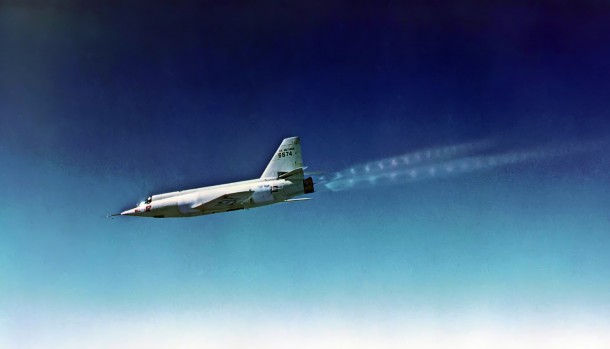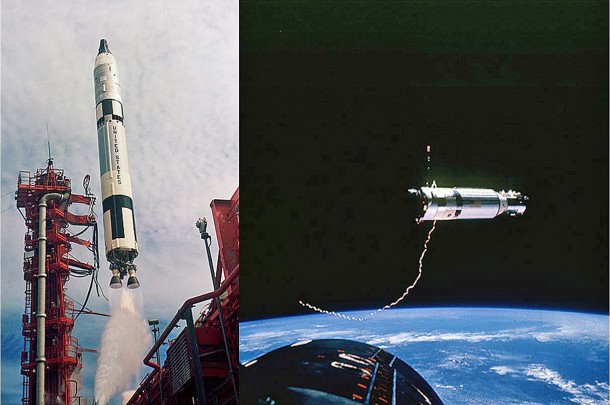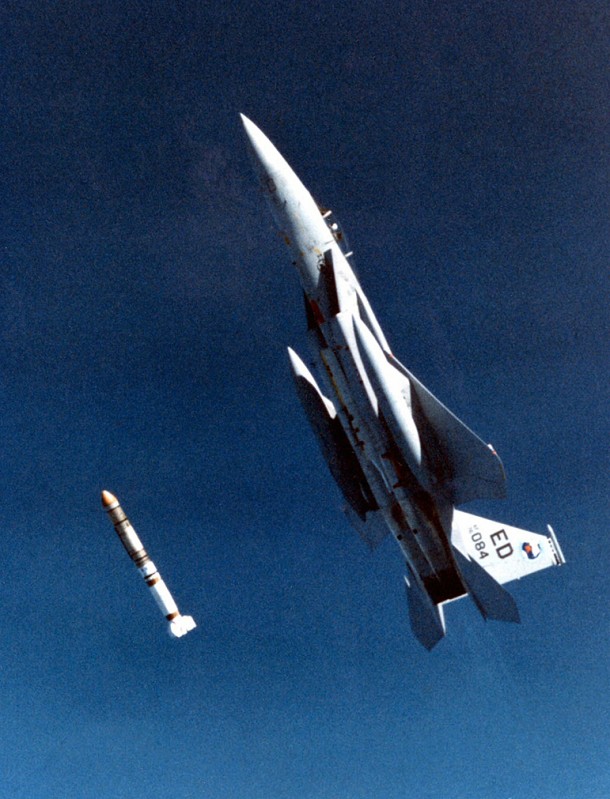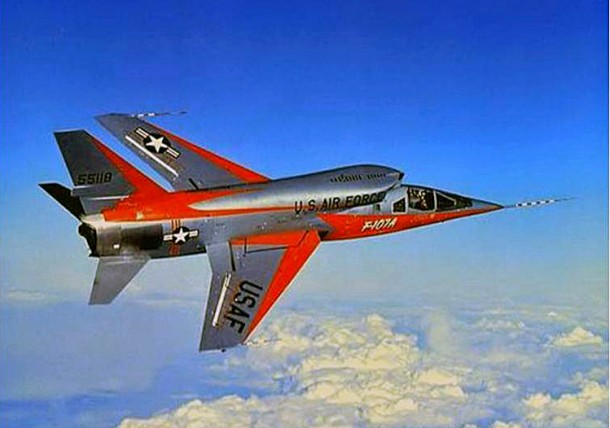
Fifty-eight years ago this week, the Bell X-2 rocket-powered research aircraft reached a record speed of 2,094 mph with USAF Captain Milburn G. “Mel” Apt at the controls. The new speed mark corresponded to a Mach number of 3.2 at an altitude of 65,000 feet.
Mel Apt’s historic achievement came about because of the Air Force’s desire to have the X-2 reach Mach 3 before turning it over to the National Advisory Committee For Aeronautics (NACA) for further flight research testing. Just 20 days prior to Apt’s flight in the X-2, USAF Captain Iven C. Kincheloe, Jr. had flown the aircraft to a record altitude of 126,200 feet.
On Thursday, 27 September 1956, Apt and the last X-2 aircraft (S/N 46-674) dropped away from the USAF B-50 motherhip at 30,000 feet and 225 mph. Despite the fact that Apt had never flown an X-aircraft, he executed the flight profile exactly as briefed. In addition, the X-2′s twin-chamber XLR-25 rocket motor burned propellant 12.5 seconds longer than planned. Both of these factors contributed to the aircraft attaining a speed in excess of 2,000 mph.
Based on previous flight tests as well as flight simulator sessions, Apt knew that the X-2 had to slow to roughly Mach 2.4 before turning the aircraft back to Edwards. This was due to degraded directional stability, control reversal, and aerodynamic coupling issues that adversely affected the X-2 at higher Mach numbers.
However, Mel Apt was now faced with a difficult decision. If he waited for the X-2 to slow to Mach 2.4 before initiating a turn back to Edwards Air Force Base, he quite likely would not have enough energy and therefore range to reach Rogers Dry Lake. On the other hand, if he decided to initiate the turn back to Edwards at high Mach number, he risked having the X-2 depart controlled flight. Flying in a coffin corner of the X-2’s flight envelope, Apt opted for the latter.
As Apt increased the aircraft’s angle-of-attack, the X-2 departed controlled flight and subjected him to a brutal pounding. Aircraft lateral acceleration varied between +6 and -6 g’s. The battered pilot ultimately found himself in a subsonic, inverted spin at 40,000 feet. At this point, Apt effected pyrotechnic separation of the X-2′s forebody which contained the cockpit and a drogue parachute.
X-2 forebody separation was clean and the drogue parachute deployed properly. However, Apt still needed to bail out of the X-2′s forebody and deploy his personal parachute to complete the emergency egress process. But, it was not to be. Mel Apt ran out of time, altitude, and luck. He lost his life when the X-2 forebody that he was trying to escape from impacted the ground at several hundred miles an hour.
Mel Apt’s flight to Mach 3.2 established a record that stood until the X-15 exceeded it in August 1960. However, the price for doing so was very high. The USAF lost a brave test pilot and the lone remaining X-2 on that fateful day in September 1956. The mishap also ended the USAF X-2 Program. NACA never did conduct flight research with the X-2.
However, for a few terrifying moments, Mel Apt was the fastest man alive.

Forty-eight years ago today, Gemini 11 completed a spectacular 3-day mission that helped pave the way to the first manned lunar landing. The all-Navy crew included astronauts Charles P. Conrad, Jr. and Richard F. Gordon, Jr.
America’s manned space effort of the 1960′s and early 1970′s consisted of the Mercury, Gemini and Apollo Programs. Mercury put the first Americans into space and gave the country a basic manned spaceflight capability. Apollo put Americans on the Moon and returned them safely to the Earth. Gemini was the bridge. Without it, the United States could not have achieved the national goal of landing men on the Moon before the end of the 1960′s.
The Gemini Program consisted of ten (10) manned spaceflights that were flown between March of 1965 and December 1966. Gemini 11 was the penultimate mission. Its primary goals included performing a direct ascent rendezvous, increasing its orbital altitude by more than 500 NM, using tethered flight to produce artificial gravity, conducting several space walks and performing a computer-controlled precision landing.
Gemini 11 lifted-off from Cape Canaveral’s LC-19 at 14:42:26 UTC on Monday, 12 September 1966. The initial orbit was 151-NM (apogee) by 87-NM (perigee). Relying on radar and a primitive flight computer, it took Conrad and Gordon about 85 minutes to successfully perform history’s first direct ascent or first-orbit rendezvous. Their target was an Agena Target Vehicle (GATV-11) which had been launched 90 minutes prior to Gemini 11′s lift-off.
Approximately 24 hours into the Gemini 11 mission, Gordon initiated the first of two planned Extra Vehicular Activities (EVA’s). His first task was to connect a 100-foot tether between the Gemini and Agena spacecraft. While he did so successfully, Gordon was exhausted from the effort. He perspired so heavily that his helmet face plate fogged-over. The remainder of the EVA was cancelled when Conrad commanded Gordon to return to the Gemini.
At a mission elapsed time of about 40.5 hours, the Gemini 11 crew fired-up the Agena’s rocket engine for a 25 second burn. This action increased the apogee of the Gemini-Agena stack to a record altitude of 739 NM. Following two (2) highly-elliptical orbits, the Agena’s rocket engine was once again ignited. The result of this rocket engine burn was to lower the spacecraft and its crew to a near-circular 164 NM x 155 NM orbit.
Roughly 46 hours into the mission, Gordon conducted a second EVA. This time Gordon would simply stand-up in his seat and conduct several hours of photographic experiments. Doing so was not physically-taxing and Gordon’s efforts were entirely successful.
Following successful completion of the second EVA, the Gemini undocked from the ATV. With the spacecraft still connected by the 100-foot tether, the crew used the Gemini’s thrusters to establish a slow rotation of the pair until the tether became taut. The idea was to induce a small artificial gravity between the rotating spacecraft. Keeping the tether taut was not easy. While this was another first for Gemini, the maximum artificial gravity induced was a paltry 0.00015-g.
Upon completion of the tethered-flight experiment, the tether connecting Gemini 11 and the GATV-11 was released at a mission elapsed time of about 51 hours. The Gemini 11 crew performed additional spacecraft manuevers and conducted a variety of spaceflight experiments over the next 19 hours. However, Gemini 11 had one more historic space-first to accomplish before mission’s end.
As the 70th hour of flight neared completion, the crew fired the Gemini 11 retro rocket system to begin their return to Earth. For the first time, a Gemini crew would allow a computer to control the reentry. A so-called “hands-off” reentry. All previous Gemini reentries were manually controlled by the command pilot.
Gemini 11 splashed-down in the western Atlantic Ocean at 13:59:35 UTC on Thursday, 15 September 1966. The computer did a pretty good job of controlling the reentry too. The spacecraft landed within 2.4 NM of the USS Guam; only 1.3 NM off target. The accurate landing allowed recovery of, first the crew, then the spacecraft, aboard the Guam within an hour of landing. Mission total elapsed time was 71 hours, 17 minutes and 8 seconds.
For their significant efforts on Gemini 11, the crew of Conrad and Gordon would eventually fly to the Moon during the Apollo Program. Indeed, Pete Conrad was the Commander of Apollo 12 and the third American to walk on the Moon. (Alan Bean, the Apollo 12 Lunar Module Pilot, was the fourth man to walk the lunar surface.) The Apollo 12 Command Module Pilot was none other than Conrad’s good friend and Gemini 11 co-pilot Richard Gordon.

Twenty-nine years ago this week, the USAF/LTV ASM-135 anti-satellite missile successfully intercepted a target satellite orbiting 300 nautical miles above the Earth. The test was the first and only time that an aircraft-launched missile successfully engaged and destroyed an orbiting spacecraft.
The United States began testing anti-satellite missiles in the late 1950′s. These and subsequent vehicles used nuclear warheads to destroy orbiting satellites. A serious disadvantage of this approach was that a nuclear detonation intended to destroy an adversary satellite will likely damage nearby friendly satellites as well.
By the mid 1970′s, the favored anti-satellite (ASAT) approach had changed from nuclear detonation to kinetic kill. This latter approach required the interceptor to directly hit the target. The 15,000-mph closing velocity provided enough kinetic energy to totally destroy the target. Thus, no warhead was required.
The decision to proceed with development and deployment of an American kinetic kill weapon was made by President Jimmy Carter in 1978. Carter’s decision came in the aftermath of the Soviet Union’s successful demonstration of an orbital anti-satellite system.
LTV Aerospace was awarded a contract in 1979 to develop the Air-Launched Miniature Vehicle (ALMV) for the USAF. The resulting anti-satellite missile (ASM) system was designated the ASM-135. The two-stage missile was to be air-launched by a USAF F-15A Eagle executing a zoom climb. In essence, the aircraft acted as the first stage of what was effectively a 3-stage vehicle.
The ASM-135 was 18-feet in length and 20-inches diameter. The 2,600-lb vehicle was launched from the centerline station of the host aircraft. The ASM consisted of a Boeing SRAM first stage and an LTV Altair 3 second stage. The vehicle’s payload was a 30-lb kinetic kill weapon known as the Miniature Homing Vehicle (MHV).
The ASM-135 was first tested in flight on Saturday, 21 January 1984. While successful, the missile did not carry a MHV. On Tuesday, 13 November 1984, a second ASM-135 test took place. Unfortunately, the missile failed when the MHV that it was carrying was aimed at a star that served as a virtual target. Engineers went to work to make the needed fixes.
In August of 1985, a decision was made by President Ronald Reagan to launch the next ASM-135 missile against an orbiting US satellite. The Solwind P78-1 satellite would serve as the target. Congress was subsequently notified by the Executive Branch regarding the intended mission.
The historic satellite takedown mission occurred on Friday, 13 September 1985. USAF F-15A (S/N 77-0084), stationed at Edwards Air Force Base, California and code-named Celestial Eagle, departed nearby Vandenberg Air Force Base carrying the ASM-135 test package. Major Wilbert D. Pearson was at the controls of the Celestial Eagle.
Flying over the Pacific Ocean at Mach 1.22, Pearson executed a 3.8-g pull to achieve a 65-degree inertial pitch angle in a zoom climb. As the aircraft passed through 38,000-feet at Mach 0.93, the ASM-135 was launched at a point 200 miles west of Vandenberg. Both stages fired properly and the MHV intercepted the Solwind P78-1 satellite within 6-inches of the aim point. The 2,000-lb satellite was completely obliterated.
In the aftermath of the stunningly successful takedown of the Solwind P78-1 satellite, USAF was primed to continue testing the ASM-135 and then introduce it into the inventory. Plans called for upwards of 112 ASM-135 rounds to be flown on F-15A aircraft stationed at McChord AFB in Washington state and Langley AFB in Virginia. However, such was not to be.
Even before the vehicle flew, the United States Congress acted to increasingly restrict the ASM-135 effort. A ban on using the ASM-135 against a space target was put into effect in December 1985. Although USAF actually conducted successful additional ASM-135 flight tests against celestial virtual targets in 1986, the death knell for the program had been sounded.
In the final analysis, a combination of US-Soviet treaty concerns, tepid USAF support and escalating costs killed the ASM-135 anti-satellite effort. The Reagan Administration formally cancelled the program in 1988.
While the ASM-135 effort was relatively short-lived, the technology that it spawned has propagated to similar applications. Indeed, today’s premier exoatmospheric hit-to-kill interceptor, the United States Navy SM-3 Block IA anti-ballistic missile, is a beneficiary of ASM-135 homing guidance, intercept trajectory and kinetic kill weapon technologies.

Fifty-eight years ago this month, the USAF/North American F-107A aircraft flew for the first time. Interestingly, the Mach 2-capable fighter-bomber prototype went supersonic on its maiden flight.
The F-107A was designed, developed and tested by North American Aviation (NAA) in the mid-1950′s. With it, the contractor hoped to satisfy Tactical Air Command’s (TAC) need for a front line fighter-bomber. However, Republic Aircraft also had a candidate for the same role; the F-105 Thunder Chief.
The competition between Republic and North American for the TAC fighter-bomber production contract has a story of its own. Suffice it to say here that the competitive effort was (1) extremely close and (2) tinged with political intrigue. In the end, Republic Aircraft reaped the spoils of victory.
Although the F-107A came out on the short end of the stick in the TAC fighter-bomber competition, such did not imply an inferiority in fulfilling the intended role. Indeed, like the Northtrop YF-23′s loss to the General Dynamics YF-22 in the ATF competition of the early 1990′s, North American’s failure to get the nod with the F-107A is still a subject of passionate debate.
The F-107A measured 60.8 feet in length and had a wing span of 36.6 feet. Gross take-off weight was around 41,000 pounds. The aircraft was powered by a single Pratt and Whitney YJ75-P-11 turbojet that produced 15,500 pounds of thrust in military power and 23,500 pounds of thrust in full afterburner.
F-107A longitudinal control was provided by an all-flying horizontal tail. Similarly, an all-flying vertical tail was employed for directional control. Lateral control was provided by a unique 3-segment spoiler-deflector system mounted on each wing. The aircraft was also configured with inboard flaps and leading edge slats for lift augmentation at low speeds.
A unique and prominent feature of the F-107A was its dorsal-mounted air induction system known as the Variable-Area Inlet Duct (VAID). Internally, this unit incorporated a system of adjustable ramps to efficiently decelerate and compress freestream prior to entering the engine compressor face. Ramp deflection scheduling with Mach number was controlled automatically. Ramp boundary layer bleed air was vented from the top of the VAID.
The F-107A carried weapons externally. In addition to wing pylon-mounted stores, the aircraft was designed to carry a single “special weapon” from a semi-submerged recess located on the aircraft ventral centerline. The term “special weapon” means that it was a tactical nuclear bomb. The Sandia-developed store could also be used in combination with a special saddle fuel tank to extend aircraft range.
A total of three (3) F-107A aircraft were built and flown. USAF-assigned tail numbers include 55-5118, 55-5119 and 55-5120. On Monday, 10 September 1956, the No. 1 ship (55-5118) took-off from Edwards Air Force Base on its first flight. NAA Chief Test Pilot Robert Baker, Jr. was at the controls. The aircraft attained a maximum Mach number of 1.03 in a 43 minute flight test.
The F-107A could really scream. The type had a maximum climb rate of around 40,000 feet per minute in full afterburner. The max demonstrated Mach number attained by the F-107A was Mach 2.18. Program engineers estimated that by increasing the inlet area slightly, the F-107A was capable of reaching roughly Mach 2.4.
The trio of F-107A aircraft flew 272 flight tests totalling 176.5 hours. Included in this testing was successful separation of a special store prototype at Mach 2. Test pilots of note who flew the F-107A included XB-70A pilot Al White and X-15 pilots Scott Crossfield, Bob White, Jack McKay and Forrest Peterson.
Though it never became a production aircraft, the F-107A contributed in significant ways to aviation progress. Indeed, many future aircraft would greatly benefit from F-107A flight control and air induction technology including the A-5 Vigilante, XB-70A, A-12, SR-71, YF-12A and F-15.
The F-107A was the last of NAA’s fighter aircraft which includes such notables as the P-51 Mustang, the F-86 Sabre and the F-100 Super Sabre. While the F-107A has often been referred to in print as the Ultra Sabre, Ultimate Sabre, Super Super Sabre or such, it was never officially assigned a nickname. Alas, there was never an XF-107A or YF-107A designation either. North American Aviation’s TAC fighter-bomber candidate was simply known as the F-107A.
Today, the No. 1 F-107A (55-5118) is displayed at the Pima Air and Space Museum (PASM) in Tucson, Arizona. The No. 2 ship (55-5119) resides at the USAF Museum at Wright-Patterson Air Force Base in Dayton, Ohio. The No. 3 airplane (55-5120) no longer exists as it was relegated to the status of a fire fighting prop and ultimately destroyed in that role sometime in 1961 or 1962.





